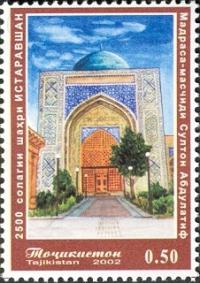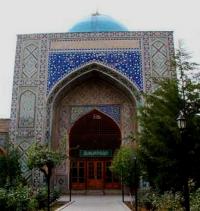Вы здесь
Abdulatif Sultan a mosque.


Excursion on mosques Istaravshan.
Mosque Abdulatif Sultan, still name "Cook-Gumbez", «The Blue dome», it is considered one of the main places of interest of the ancient city of Istaravshan located in 78 km from Khudjand. To look at it there come the people, were interested history and culture of Central Asia.
The building of a mosque-медресе is dated XVI century. National legends say, that it has been constructed under initiative Абдулатифа of the Sultan - the son of the well-known astronomer, the philosopher and governor Ulugbek who is considered in Central Asia by the person esteemed.
Decoding chronogram which have been written above its front entrance confirms, that this monument has been constructed Abdulatif in 937 (1530 - 1531). Archeological excavations testify To it in territory madrasah also.
Under documents, in the beginning this construction intended for madrasah (the school training in different directions). Madrasah has strongly suffered in 1866 during an attack of imperial (Russian) armies to Central Asia and a gain of Ura-Tobe.
The Russian armies have caused strong damage Madrasah Abdulatif Sultan, but also to other memorable constructions of the city of Istaravshan. On legend Abdulatif Sultan has quarrelled with the father and it was employed in simple workers to the old man, helping to dig canal for water a site.
Ulugbek in the meantime continued to search for the son. When he has learned, where works Abdulatif Sultan, he has taken away the money earned by the son from the old man, has added to them own means and has given them on erections of school-madrasahе and a mosque.
The school has appeared the extremely demanded - she continued to work even three centuries later, in the end of XIX century 44 students here were trained and taught 8 teachers.
The main building of a mosque costs in depth of the big court yard enclosed by an arcade.
It consists of the central part with a high portal and two lateral galleries with arches and brick columns. The building from a square brick is combined, the entrance portal and a dome are reveted by a blue majolica and mosaics.
In an internal premise four deep niches on the parties, increasing space are stipulated. Nish with mikhrab, specifying a direction to Mecca, it is decorated by an alabaster stucco moulding and изразцовой an inscription.
At madrasah there were not only premises for ablution, but also other utilitarian halls. There it was possible to drink, for example, to tea, to have a rest or even to use services of the hairdresser.
Imperial armies have decided to spend restoration works in madrasah only later 10 years, in 1876. The paper which has been found out under a layer of plaster of a column testifies to it. Madrasah have restored still twice in 1904 and 1913.
Double repair of this building during approximately 15 years has been caused by earthquakes 1897 both 1902 and decay of a building. Within Great Domestic war madrasah it was used as a warehouse.
In 50-s' years of XX century the Soviet authority of the beginning restoration works in madrasah. They proceeded almost 10 years and have remained not finished. Only in 1998 under the initiative of chairman of area of Kasymova K.R. means from Sogd the regional budget have been allocated and madrasah have restored.
By documents, in 1899 in медресе studied 44 mullobacha (student) and taught 8 muddarisв (teachers).
Authorship:
The Tourist guidebook on monuments of Tajikistan. 2012.







